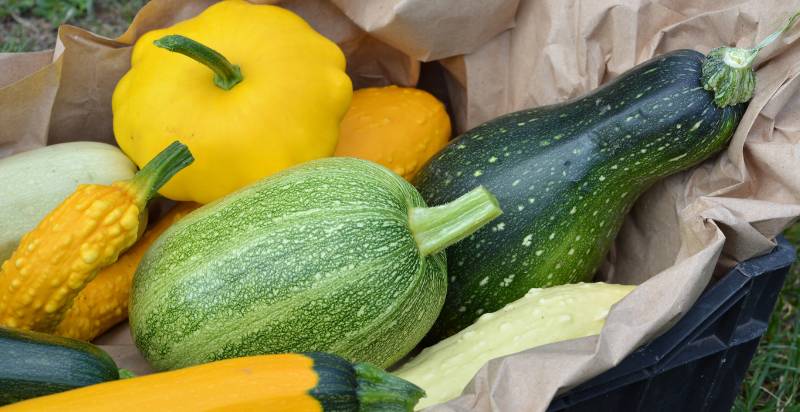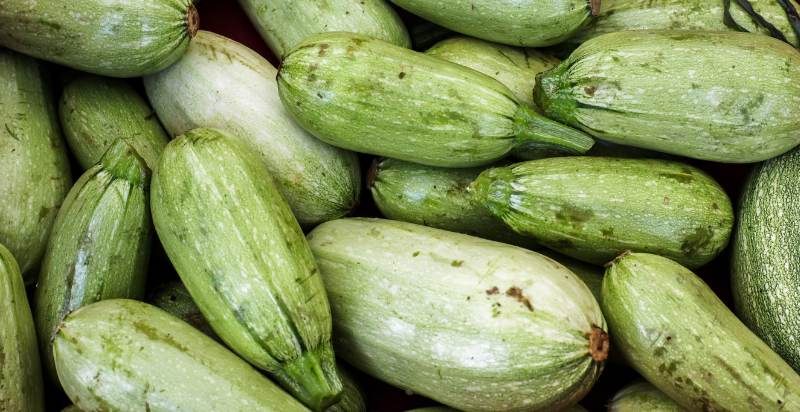Summer squash is an incredibly popular and versatile vegetable that can be cooked in various ways. It’s a great addition to any meal, whether for breakfast, lunch, or dinner. Summer squash is also very nutritious and contains vitamins and minerals like vitamin C, magnesium, and potassium.
While there are many types of summer squash, some of the most popular varieties include zucchini, yellow crookneck squash, patty pan squash, and spaghetti squash. In this article, we’ll discuss the nutritional value of summer squash and provide tips on preparing it in delicious dishes!
What is Summer Squash?
Summer squash is a type of vegetable that belongs to the Cucurbitaceae family, which includes melons, cucumbers, and gourds. It’s available in wide varieties, including zucchini, yellow crookneck squash, patty pan squash, and spaghetti squash. Summer squash has a mild flavor and can be eaten raw or cooked. It’s an excellent source of nutrition with high levels of vitamins such as Vitamin A, B6, and C and minerals like magnesium and potassium.
History and Origin of Summer Squash:
Summer squash is believed to have originated in the Americas and dates back as far as 5,000 BC. It is a member of the Cucurbitaceae family, including cucumbers, melons, pumpkins, and gourds. There are wide varieties of summer squash, including zucchini, yellow crookneck, pattypan, scallopini, and more.
Summer squash is a popular vegetable used in various dishes, from casseroles to salads. It is high in vitamins A, C, K, and B6 and essential minerals like magnesium, manganese, and potassium. Summer squash is also low in calories and can be an excellent addition to any healthy diet. It can be roasted, steamed, grilled, or sautéed for a delicious meal or side dish. Summer squash is the perfect vegetable for summertime cooking! Enjoy it fresh or frozen all year round.
Types of Summer Squash:
Summer squash is divided into two main types: vining and bush.
Vining summer squash, such as zucchini and crookneck, have vines that can reach up to 5 feet in length and need plenty of space to grow. These plants should be given ample room to spread out, so they are best planted in a garden bed or along a fence line.
Bush varieties like pattypan and scallopini don’t require much space and will happily thrive in smaller spaces. They produce compact plants with large leaves that keep their fruits off the ground, so they don’t rot easily.
In addition to the standard varieties, there is also a third type of summer squash called “hybrid” squash. These varieties are a mix of different types and often feature unique shapes, colors, and flavors. They tend to be easy to grow and yield larger crops than the standard varieties.
No matter which type of summer squash you choose to grow, they all share the same basic needs, like full sun, ample water, and well-draining soil. You can enjoy a bountiful harvest of these delicious vegetables with proper care throughout the summer!

Nutrients in Summer Squash:
Summer squash is an excellent source of many essential vitamins and minerals. It is a good source of vitamin A, which helps support vision and healthy skin, and vitamin C, which helps maintain the immune system and supports collagen production for healthy skin and joints. Summer squash also contains various B vitamins such as thiamin, riboflavin, niacin, vitamin B6 and folate. These B vitamins provide energy for the body and help with brain function and cellular metabolism.
Summer squash is also a good source of minerals such as magnesium, potassium, phosphorus, and zinc, which are essential for bone health and assist muscle and nerve functions. Lastly, summer squash contains dietary fiber that helps promote healthy digestion and can help control blood sugar levels. With all the essential vitamins and minerals, summer squash is a great addition to any diet. It’s delicious, nutritious, and versatile! Enjoy it in salads, stir-fries, or an easy side dish.
Uses of Summer Squash:
Summer squash is an extremely versatile vegetable that can be used in a variety of dishes. It can be boiled, steamed, roasted, grilled, stuffed, and baked. Summer squash can be added to salads for a bit of crunch or made into soups and stews. It can also be diced up and used as a topping on pizzas or mixed with other vegetables and served as a side dish. Summer squash is also often included in stir-fries, frittatas, or casseroles.
The summer squash seeds are edible, too; they can be roasted like pumpkin seeds for a tasty snack! Additionally, summer squash can be blended into smoothies for added nutrients, and its mild flavor won’t overpower the other ingredients.
How to Plant Summer Squash?
Summer squash, like zucchini, yellow crookneck squash, and pattypan varieties, are some of the most popular vegetables to grow in the home garden. They have a mild flavor that adds texture and crunchy freshness to summer meals. And they’re just so easy to grow! You need plenty of sun, good soil, and proper care—and you’ll be picking bowls full of delicious summer squash in no time!
Selecting A Site for Planting:
When deciding where to plant your summer squash plants, it’s important to consider sunlight and water drainage. Summer squash loves lots of sunshine and will thrive when planted in a spot with at least 6 hours of direct sunlight daily. It’s also important that the soil drains well, as squash doesn’t do well in areas with poor drainage or standing water.
Preparing The Soil:
Before planting your summer squash, it’s important to prepare the soil. Loosen and aerate the top 6 inches of soil using a garden fork or tiller, and then mix in 2-3 inches of organic matter such as compost or aged manure. This will help boost nutrient levels, moisture retention, and drainage. Additionally, you should add 1-2 tablespoons of balanced fertilizer every foot of a row before planting to ensure optimal growth and production.
Planting Your Squash:
Once your soil is ready, you can begin the planting process. Plant your summer squash seeds a half-inch deep in rows spaced at least two feet apart. When planting multiple plants, space them 8-10 inches apart in their row for optimum growth. Water thoroughly after planting and then regularly throughout the season to keep the soil moist but not soggy.
Caring For Your Squash:
To ensure healthy and abundant yields of summer squash, it’s important to provide proper care aside from regular watering. To encourage better yield and quality of produce, lightly fertilize your squash with a balanced fertilizer every 3-4 weeks throughout the growing season. Additionally, mulching around the base of your plants will help keep weeds down and moisture retention up, enhancing growth.
Harvesting Your Squash:
The best time to harvest summer squash is when the fruits are tender, usually after about 6-8 weeks of growth. To pick the fruits, hold them in one hand and gently twist them off with the other—avoid pulling or yanking as this may damage both the fruit and plant. Once harvested, store your squash in a cool, dry place until you’re ready to use it.
By following these simple steps on how to plant summer squash, you’ll be enjoying fresh, delicious produce all season long. All that’s left now is to get out there and start planting!
How to Care for and Grow Summer Squash?
Summer squash is a popular vegetable that is easy to care for and grow. Choosing the right variety of summer squash is important, as some require more maintenance than others. Once you’ve chosen the right variety, it’s time to start! Here are some tips on how to care for and grow summer squash:
- Plant in full sun: Summer squash needs at least 6-8 hours of direct sunlight per day. Choose a spot in your garden that gets plenty of sunshine throughout the day.
- Provide adequate water: Water regularly, so the soil stays moist but not soggy—too much water can cause root rot or invite pests. A good rule of thumb is one inch of water per week during the growing season.
- Fertilize: Summer squash needs a steady supply of nutrients to reach its full potential. Fertilize your summer squash plants every two weeks with an organic fertilizer such as fish emulsion or compost tea.
- Control weeds: Keep the area around your summer squash clean by regularly pulling any weeds you find. Weeds can compete with your squash for water and nutrients, so keeping them at bay is important.
- Monitor pests and diseases: Check your plants frequently for signs of pests or disease—such as aphids, whiteflies, or powdery mildew—and take action if needed. Use natural pest control methods, such as introducing beneficial insects or planting companion plants.
- Harvest when ripe: Summer squash is ready to be harvested as soon as it reaches full size. Cut the stem close to the fruit and use pruning shears or scissors for a clean cut. The fruits taste much better if you harvest them at their peak ripeness!
With proper care, summer squash can be a rewarding addition to your garden. Enjoy the delicious fruits of your labor!

Preventions from Pests and Diseases:
Practices for preventing pests and diseases in Summer Squash include:
- Plant summer squash varieties that are resistant to common diseases.
- Rotate crops and plants in different areas of the garden each year. This reduces the buildup of soil-borne organisms that can affect summer squash.
- Weed regularly around plants to reduce spaces where pests can hide.
- Use floating row covers or insect netting to keep out flying insects such as squash bugs and cucumber beetles. Remove when flowers appear so pollinators can access plants.
- Keep harvested fruits picked regularly and remove any damaged or diseased fruit on an ongoing basis.
- Never work with wet foliage, as this increases the risk of spreading disease.
- Avoid watering plants late afternoon or evening as many diseases spread most easily.
- Maintain a 3-4 inch layer of mulch around plants to help retain soil moisture and reduce weed growth.
- Treat pest outbreaks with insecticidal soap, neem oil, or other natural solutions that are safe for gardens and edible plants. Always read product labels and follow directions carefully.
By following these preventative steps for Summer Squash, gardeners can help ensure their crops remain healthy and productive throughout the season.
How to Harvest Summer Squash?
Harvesting summer squash is relatively easy. It would be best to wait until the squash was fully developed and had hard, glossy skin. The size of the squash will depend on your variety and how long you let it develop.
When harvesting, use a sharp knife or pruning shears to cut off the stem an inch or two from the fruit. Handle summer squash gently, as they are fragile vegetables with thin skins that can easily be punctured or damaged when handled roughly.
Check your plants often for ripe fruit so you can harvest them before they become overripe and inedible. For larger varieties like zucchini, look for fruits around 8 inches long and 2-3 inches in diameter; for smaller varieties, pick when they are 4-5 inches long.
When harvesting, remember to leave some of the fruit on the plant so that it can continue to produce. This will also help reduce stress on the plant and encourage more production for you to enjoy later in the season.
Once harvested, store summer squash in a cool, dry place for up to one week or refrigerate for up to two weeks. Enjoy your harvest!

How to Store Homegrown Summer Squash?
When storing homegrown summer squash, you must consider how long you plan to keep it. If you plan to eat the squash within a few days, then storing it in the refrigerator is ideal. Place the squash in an airtight container or bag and store it in the coldest part of your fridge for up to one week.
Freezing is recommended if you want to store the summer squash for a longer period. To freeze summer squash:
- Wash and cut it into cubes or slices.
- Bring a large pot of water to a boil and blanch the cubes for about two minutes before draining and cooling them off with cold water.
- Lay out single layers of cubes on parchment paper-lined baking sheets, and freeze.
Once frozen, transfer to airtight containers or freezer bags and store in the freezer for up to eight months.
Another way to store summer squash is by pickling it. To pickle summer squash, slice it into thin rounds or cubes and pack it tightly into jars with your desired spices and herbs. Place in a sealed container and store in the refrigerator for up to two months.
Finally, you can dehydrate summer squash for longer-term storage of up to a year or more. Slice into 1/4-inch thick pieces using a knife or mandolin slicer before arranging on parchment paper-lined baking sheets. Dehydrate at 115°F (46°C) until completely dry and brittle, then store in an airtight container or vacuum seal bag.
No matter how you store homegrown summer squash, keeping it properly sealed and free from moisture is important. Doing so will help ensure that the squash stays fresh as long as possible!
How to Use Homegrown Summer Squash?
Summer squash can be used in a variety of ways. For starters, you can use it in soups and stews. Cut the squash into cubes or slices and add it to your favorite recipes. For a delicious side dish, you can also bake summer squash in the oven with your favorite seasoning. Roasting summer squash is another easy way to enjoy this vegetable; slice it into rounds, toss it with a touch of oil, seasonings, and some minced garlic then bake until golden brown.
Summer squash is also great for grilling! Slice the squash into thick slices and brush generously with olive oil before placing it on the preheated grill. Grill for about five minutes per side over medium heat, flipping once during cooking. Season with salt and pepper to taste. Serve the grilled summer squash as a side dish, or top it with your favorite cheese and herbs for a delicious main course.
You can also use summer squash in salads. Slice it into thin slices, then layer it on top of your favorite greens and veggies. Drizzle some olive oil, vinegar, and seasonings over the salad for extra flavor. Or you can shred the squash into small ribbons and mix it with other grated vegetables such as carrots and beets to make an even more flavorful salad.
And lastly, don’t forget about summer squash casseroles! Sauté onion until softened, and add cubed summer squash to the pan, canned tomatoes, and seasonings. Pour the mixture into a greased casserole, top with cheese and your favorite herbs, then bake until golden brown. Enjoy! With its mild flavor and versatility in the kitchen, summer squash is sure to become a staple of your cooking repertoire. Try out some of these delicious recipes today.

Potential Risks from Summer Squash:
Summer squash, like many vegetables, can contain harmful bacteria such as E. coli and Salmonella if not properly washed and stored. Be sure to wash all summer squash thoroughly under running water before cooking or consuming it raw. When cutting the squash, use a clean knife or food processor and keep it away from other uncooked foods contaminated with bacteria.
Additionally, some people may experience an allergic reaction when eating summer squash due to its high content of oxalates and sulfites. If you’ve never eaten summer squash before, start by consuming small amounts first to ensure your body can tolerate it without adverse reactions.
Conclusion:
With its mild flavor and versatility, summer squash can be a great addition to any home garden or kitchen. It’s easy storage options allow you to enjoy your homegrown summer squash for weeks or even months after harvesting it. Remember to handle and store the squash properly to ensure safety and quality. Experiment with different recipes to find out how delicious summer squash can be! Enjoy!
Join us in exploring the candy roaster squash, a delightful and sweet variety of squash. Our article breaks down what makes it unique and how you can use it to spice up your cooking.
- Water Berries: Description, Flavor, Benefits, And Uses - June 18, 2024
- Everything You Wanted To Know About Sweetheart Cherries - June 17, 2024
- Indian Jujube: Description, Flavor, Benefits, And Uses - April 30, 2024

16 thoughts on “What is Summer Squash? How to Plant, Grow, and Harvest Summer Squash”
Comments are closed.